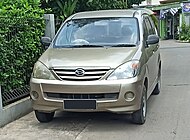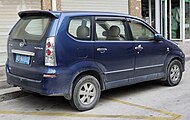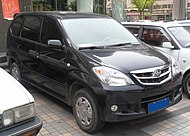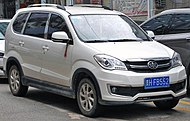
A | B | C | D | E | F | G | H | CH | I | J | K | L | M | N | O | P | Q | R | S | T | U | V | W | X | Y | Z | 0 | 1 | 2 | 3 | 4 | 5 | 6 | 7 | 8 | 9
| Toyota Avanza | |
|---|---|
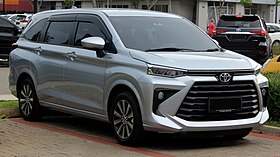 2022 Toyota Avanza 1.5 G TSS (W101RE, Indonesia) | |
| Overview | |
| Manufacturer | |
| Also called |
|
| Production | December 2003 – present |
| Body and chassis | |
| Class |
|
| Body style | |
| Layout |
|
| Chronology | |
| Predecessor | Toyota Kijang (F70) |
The Toyota Avanza and Daihatsu Xenia are a series of multi-purpose vehicles (MPV) developed by Daihatsu and marketed by both Toyota and Daihatsu, mainly sold with three-row seating.[4][5] The Avanza and Xenia were developed as an entry-level MPV marketed mainly for the Indonesian and other emerging markets, and mainly produced in Indonesia by Astra Daihatsu Motor.[6] Avanza's spiritual predecessor was the Kijang, whose model program has since been split into two different models (the other being the larger Kijang Innova) to expand Toyota's reach in the MPV sector.
In addition to Indonesia, the Avanza is sold throughout Southeast Asia, Mexico, Pakistan, Nepal, Bangladesh, Sri Lanka, the Middle East, Caribbean, Egypt, South Africa and other various African countries. A rebadged version of the car was sold in China under the FAW badge until 2016.[7]
In 2021, the Avanza spawned another twin model called the Toyota Veloz, which the "Veloz" name was previously used for Avanza's flagship grade level for some markets between 2011 and 2021. The Avanza also served as a basis for the second-generation Perodua Alza, which was introduced in Malaysia in 2022.[1]
The Avanza was the best-selling passenger car in Indonesia between 2006 and 2019, and then in 2021. At the peak of its popularity in 2013, the Avanza made up 17 percent of total car sales in Indonesia (22 percent combined with the Xenia).[8] By November 2018, around 2.75 million units of Avanza/Xenia had been sold globally.[9]
Etymology
The name Avanza is derived from the Spanish word avanza which means 'get moving' and the Italian word avanzato, which means 'advance'. The name Xenia is derived from the Greek term Xenia, a concept of hospitality.[10] The name Veloz is taken from the English word 'velocity' and the Spanish word velocidad, meaning 'fast'.
Development
The Avanza and Xenia were both conceived by Toyota, Daihatsu and its Indonesian subsidiaries in the wake of the 1997 Asian financial crisis. At the time, the price of the best-selling Kijang had skyrocketed, while the economy in the country had just recovered from the crisis.[11] Feasibility studies started in 1999 when Toyota-Astra Motor proposed for a more affordable vehicle under the Kijang for the Indonesian market. Toyota Motor Corporation handed the development and manufacturing of the vehicle to Astra Daihatsu Motor due to Daihatsu's expertise on low-cost vehicles in Indonesia.[12] Toyota and Daihatsu invested a total of US$90,000,000 for the project.[13]
The project was also referred by Toyota as the U-IMV (Under-IMV) project, a reference to the Innova that sits in a segment above the Avanza which rides on the IMV platform.[14] Unlike the Kijang and the succeeding Kijang Innova that both utilised full body-on-frame chassis, the first two generations of Avanza/Xenia used a semi-unibody chassis where the front half of the chassis used body-on-frame construction, while the rear half used monocoque construction.[15][16] This hybrid-type chassis made it possible for the vehicle to retain the rear-wheel-drive layout from the previous generations of Kijang along with its ability to handle heavier loads. According to journalists, it also came with several downsides such as unstable ride during high speeds and unrefined NVH levels.[17]
The second-generation model retained the same platform as the original model and took 4 years of development. Toyota and Daihatsu invested Rp 900,000,000,000 for the project.[18]
The third-generation model ditched the semi-unibody chassis with rear-wheel-drive layout in favour of the full unibody construction of the Daihatsu New Global Architecture with front-wheel-drive layout. According to Toyota and Daihatsu, the switch was made as the infrastructure quality had improved in Indonesia, along with efficiency, performance and comfort benefits of the front-wheel-drive layout.[19]
The first-generation Avanza/Xenia was assembled at the first Indonesian Daihatsu plant in Sunter, Jakarta. Between 2008 and 2011, Toyota also manufactured the car in Karawang under contract to meet the high demand.[20] The second-generation model is assembled at the same plant as the first-generation model and also at the second Daihatsu plant in Karawang, West Java, from April 2013 to an unspecified period.[21][22] For the third-generation model, production in Indonesia is split between the Daihatsu plant in Sunter for the Avanza and Xenia, and at the Toyota plant in Karawang for the Avanza and Veloz.[23] It was also contract assembled in Malaysia by Perodua for the first models to be sold by Toyota with the Avanza badging. Vietnamese assembly for the third-generation model is also carried out via CKD method. The Malaysian market Veloz is fully manufactured in the country since 2022, sharing the assembly line with the similar Perodua Alza.[24]
Engines
| Petrol engines | ||||||
|---|---|---|---|---|---|---|
| Chassis code | Model | Engine | Transmission | Power | Torque | Applications |
| F600/F650 | 1.0[25] | 989 cc EJ-DE DOHC 12-valve EFI straight-three | 5-speed manual | 42 kW (56 hp; 57 PS) at 5,200 rpm | 90 N⋅m (66 lb⋅ft; 9.2 kg⋅m) at 3,600 rpm | Xenia (2003–2006) |
| 989 cc EJ-VE DOHC 12-valve EFI straight-three with VVT-i | 46 kW (62 hp; 63 PS) at 5,600 rpm | Xenia (2006–2016)[26] | ||||
| F601/F651 | 1.3[25][27] | 1,298 cc K3-DE DOHC 16-valve EFI straight-four | 63 kW (84 hp; 86 PS) at 6,000 rpm | 116 N⋅m (86 lb⋅ft; 11.8 kg⋅m) at 3,200 rpm | Avanza/Xenia (2003–2006) | |
| 1,298 cc K3-VE DOHC 16-valve EFI straight-four with VVT-i | 5-speed manual 4-speed automatic |
65.5 kW (88 hp; 89 PS) at 6,000 rpm (2004–2006) 68 kW (91 hp; 92 PS) at 6,000 rpm (2006–2015) |
119 N⋅m (88 lb⋅ft; 12.1 kg⋅m) at 3,200 rpm (2004–2006) 119 N⋅m (88 lb⋅ft; 12.1 kg⋅m) at 4,400 rpm (2006–2015) |
Avanza (2004–2015) Xenia (2006–2015) | ||
| F653 | 1,329 cc 1NR-VE DOHC 16-valve EFI straight-four with Dual VVT-i | 71 kW (95 hp; 97 PS) at 6,000 rpm | 120 N⋅m (89 lb⋅ft; 12 kg⋅m) at 4,200 rpm | Avanza/Xenia (2015–2021) | ||
| W100 | 5-speed manual CVT |
72 kW (97 hp; 98 PS) at 6,000 rpm | 121 N⋅m (89 lb⋅ft; 12.3 kg⋅m) at 4,200 rpm | Avanza/Xenia (2021–present) | ||
| F602/F652 | 1.5[28][27] | 1,495 cc 3SZ-VE DOHC 16-valve EFI straight-four with VVT-i | 5-speed manual 4-speed automatic |
80 kW (107 hp; 109 PS) at 6,000 rpm (2006–2011) 76.5 kW (103 hp; 104 PS) at 6,000 rpm (2011–2015) |
141 N⋅m (104 lb⋅ft; 14.4 kg⋅m) at 4,400 rpm (2006–2011) 136 N⋅m (100 lb⋅ft; 13.9 kg⋅m) at 4,400 rpm (2011–2015) |
Avanza (2006–2015) Xenia (China, 2007–2010) |
| F654 | 1,496 cc 2NR-VE DOHC 16-valve EFI straight-four with Dual VVT-i | 76.5 kW (103 hp; 104 PS) at 6,000 rpm | 136 N⋅m (100 lb⋅ft; 13.9 kg⋅m) at 4,200 rpm | Avanza (2015–2021) Xenia (2019–2021) | ||
| W101/W151 | 5-speed manual CVT |
78 kW (105 hp; 106 PS) at 6,000 rpm | 137 N⋅m (101 lb⋅ft; 14.0 kg⋅m) at 4,200 rpm | Avanza/Veloz/Xenia (2021–present) Alza (2022–present) | ||
First generation (F600; 2003)
| First generation | |
|---|---|
 Avanza 1.3 (F601M; pre-facelift, Malaysia) | |
| Overview | |
| Model code | F600 |
| Also called | |
| Production |
|
| Assembly |
|
| Designer | |
| Body and chassis | |
| Class | Mini MPV |
| Layout | Front-engine, rear-wheel-drive |
| Related | |
| Powertrain | |
| Engine | |
| Power output |
|
| Transmission | |
| Dimensions | |
| Wheelbase | 2,655 mm (104.5 in) |
| Length | 4,070–4,120 mm (160.2–162.2 in) |
| Width | 1,630–1,640 mm (64.2–64.6 in) |
| Height | 1,685–1,695 mm (66.3–66.7 in) |
| Kerb weight | 980–1,095 kg (2,161–2,414 lb) |
Markets
Indonesia
The Avanza was unveiled on 11 December 2003[42][43] and released on 15 January 2004.[44] The car emerged from the first collaboration project between Toyota and Daihatsu in Indonesia with development led by Toyota chief engineer Kaoru Hosokawa, product planning leader of Toyota Commercial Vehicle Development Centre.[45][46] It was manufactured at Astra Daihatsu Motor's Sunter assembly plant, with 61 percent of its parts were sourced locally.[47]
While Toyota targeted a total sales of 30,000 for the year 2004, in January, a total of 25,000 bookings for the car had been received, leading to the increase of production capacity.[48][49] It sold 43,936 units in that year, which made it the third best-selling car in Indonesia.[50] The Avanza emerged as the best-selling car there from 2006, replacing the Kijang Innova which held the title in 2005.[51][52]
At launch, the Avanza was initially available with two grade levels: the 1.3 E and 1.3 G, both powered with a 1.3-litre K3-DE four-cylinder engine mated to a 5-speed manual transmission. Starting from July 2004, the limited-production 1.3 S grade with a 4-speed automatic transmission was available to the Indonesian market.[53] Similar to the export models, the 1.3-litre engine was upgraded to use variable valve timing (VVT-i) technology and individual direct ignition coils, while changing the designation to K3-VE. The variant also included the anti-lock braking system and extra sound dampening materials.[54][55] For the first time, a black exterior colour option was also added at the same time.
In July 2006, it received its first facelift with a redesigned grille, bumper, beige interior colour and updated tail lights.[56] The 1.3 E and 1.3 G grades were upgraded to use the K3-VE 1.3-litre VVT-i petrol engine, complied with Euro 2 standards.[57] In October 2006, the flagship 1.5 S grade was introduced. It is powered by a 3SZ-VE 1.5-litre VVT-i petrol engine along with dedicated front bumper, rear bumper, side skirts and grille designs.[58]
The Avanza received an update on 14 October 2008 with an updated ceiling with grooves to improve airflow, a revamped interior and steering wheel with four spokes. It received a front bumper mesh grille, added fog light garnish and a chrome accent in the rear window.[59][60] On 17 November 2009, the 1.3 E and 1.3 G grades received a 4-speed automatic transmission option.[61]
Malaysia
In Malaysia, the Avanza was unveiled on 7 October 2004 and launched on 29 October 2004. Sold through UMW Toyota distribution network,[62] it was available with a 1.3-litre engine mated to either a manual or an automatic transmission. It was assembled by Perodua by importing CKD kits from Indonesia.[63][64] In October 2006, the Avanza received its facelift in Malaysia. Two newer grades were offered: 1.3 E and 1.5 G. In 2008, the Avanza received another minor update with the introduction of 1.5 S grade.[citation needed]
In 2006, the Avanza makes up 40 percent of Toyota total sales in Malaysia and around 140,000 units were sold in the country by 2012.[57][65]
Philippines
In the Philippines, the first-generation Avanza had been on sale since 2006.[66][67] It was available in two grade levels: the J grade with a 1.3-litre engine, having no power windows and locks, and only available with a manual transmission, while the G grade has a 1.5-litre engine, and available with a five-speed manual transmission and a four-speed automatic transmission respectively. In 2008, the J grade was made available without the third row seat. This particular grade is popularly used as metered taxicabs in the Philippines. The Avanza was also updated in 2008 with an updated ceiling with grooves to improve airflow to the rear and an updated interior colour scheme.
Thailand
In Thailand, the first-generation Avanza had been on sale since mid-2004.[47][68]
Gallery
-
Avanza 1.3 (F601M; pre-facelift, Malaysia)
-
2007 Avanza 1.3 G (F601RM; facelift, Indonesia)
-
2007 Avanza 1.3 E (F601RM; facelift, Indonesia)
-
2011 Avanza 1.5 S (F602RM; facelift, Indonesia)
-
2009 Avanza 1.3 G interior (facelift, Indonesia)
Daihatsu Xenia
A twin model called Daihatsu Xenia also offered as a more affordable alternative to the Avanza in Indonesia. Generally, the Xenia is equipped with less safety equipment than the Avanza, while offering more dealer-installed accessories options such as front bumper guards, rear spoiler, or side body moulding to attract consumers. In Indonesia, the Xenia was available in three grade levels: 1.0 Mi, 1.0 Li and 1.3 Xi. Several accessories package was offered to the Li and Xi variants, including Plus, Deluxe, Family and Sporty. In November 2009, the automatic transmission option for the 1.3 Xi grade was launched.[69]
It is powered by the same 1.3-litre engine found in the Avanza and additional 989 cc EJ-DE (before 2006) and EJ-VE three-cylinder engines with power and torque rating at 42–46 kW (56–62 hp; 57–63 PS) at 5,600 rpm and 90 N⋅m (67 lb⋅ft; 9.2 kg⋅m) at 3,600 rpm.[40] To minimize the weight and the workload to the engine, the 1.0-litre variant was not available with double blower air conditioner and is fitted with 13-inch wheels. Throughout its production, the 1.0-litre Xenia was only offered with a 5-speed manual transmission.
Apart from Indonesia, the Xenia was also sold in China. It was previewed by the "D-01" crossover prototype at the Auto China in November 2006,[70] and went on sale in June 2007. Seven-seat and five-seat models (with two rows of seats), either with a 1.3-litre or a 1.5-litre engine, were available. It was produced by FAW Jilin Auto and was also sold as the FAW Senya M80.[71] It was discontinued January 2010 when Daihatsu pulled out from Chinese market and the joint venture for auto parts also dissolved in 2010. However, it continued to be produced and sold under license carrying the FAW marque.[72]
Gallery
-
Daihatsu Xenia 1.0 Li (F600RV; pre-facelift, Indonesia)
-
2010 Xenia 1.3 Xi Deluxe (F601RV; facelift, Indonesia)
-
FAW-Daihatsu Xenia (China)
FAW Senya M80/S80
In China, Daihatsu together with First Automobile Works (FAW) launched the first-generation Xenia as the FAW Senya M80 (Chinese: 一汽森雅M80; pinyin: Yīqì Sēnyǎ M80) on 21 June 2007. The Senya M80 was originally simply called the FAW Senya,[73] but later developed a whole range of products based on the Senya platform and was soon renamed to Senya M80. The crossover-styled version called the Senya S80 was introduced later.[74] Production in China was carried out at FAW Jilin Auto until 2010.[75]
The Senya S80 was revealed during the 2010 Beijing Auto Show.[76] Starting from the M80 and S80 of the Senya series, FAW Jilin started the Chinese brand Senia (森雅), which later became a brand focusing on crossovers.[77] A later facelift changed the front and rear ends of the Senya S80 which departs it from the Daihatsu-derived designs.
FAW sold 223,461 units during its production until the Senya M80/S80 was discontinued in 2016.[7]
A rebadged Senya S80 was also sold in North Korea by Pyeonghwa Motors as the Ppeokkuggi 1059 since 2013.[32]
Gallery
-
FAW Senya M80 (China)
-
Senya M80 (China)
-
Senya S80 (pre-facelift, China)
-
Senya S80 (pre-facelift, China)
-
Senya S80 (facelift, China)
-
Senya S80 (facelift, China)
Second generation (F650; 2011)
| Second generation | |
|---|---|
 2014 Avanza 1.3 E (F651RM; pre-facelift, Indonesia) | |
| Overview | |
| Model code | F650 |
| Also called |
|
| Production | October 2011 – 2023[78][79] |
| Assembly | Indonesia: Sunter, North Jakarta; Karawang, West Java (ADM) |
| Designer | List
|
| Body and chassis | |
| Class | Mini MPV |
| Layout | Front-engine, rear-wheel-drive |
| Related | Toyota Rush (F800) |
| Powertrain | |
| Engine | |
| Power output |
|
| Transmission |
|
| Dimensions | |
| Wheelbase | 2,655 mm (104.5 in) |
| Length |
|
| Width | 1,660 mm (65.4 in) |
| Height | 1,685–1,695 mm (66.3–66.7 in) |
| Kerb weight | 1,005–1,130 kg (2,216–2,491 lb) |
| Chronology | |
| Successor | Toyota Rumion (South Africa)[90][91][92] |
The second-generation Avanza was launched on 9 November 2011 in Indonesia with development led by Toyota chief engineer Kaoru Hosokawa.[93][94][95]
According to Toyota's South African division, the second-generation Avanza has been made approximately 20 kg (44 lb) lighter. Along with the use of low rolling resistance tyres, enhanced air conditioner regulation and electric power steering, the vehicle was reported to have achieved a substantial increase in fuel efficiency.[96]
Zdroj:https://en.wikipedia.org?pojem=Toyota_Avanza
Text je dostupný za podmienok Creative Commons Attribution/Share-Alike License 3.0 Unported; prípadne za ďalších podmienok. Podrobnejšie informácie nájdete na stránke Podmienky použitia.
Antropológia
Aplikované vedy
Bibliometria
Dejiny vedy
Encyklopédie
Filozofia vedy
Forenzné vedy
Humanitné vedy
Knižničná veda
Kryogenika
Kryptológia
Kulturológia
Literárna veda
Medzidisciplinárne oblasti
Metódy kvantitatívnej analýzy
Metavedy
Metodika
Text je dostupný za podmienok Creative
Commons Attribution/Share-Alike License 3.0 Unported; prípadne za ďalších
podmienok.
Podrobnejšie informácie nájdete na stránke Podmienky
použitia.
www.astronomia.sk | www.biologia.sk | www.botanika.sk | www.dejiny.sk | www.economy.sk | www.elektrotechnika.sk | www.estetika.sk | www.farmakologia.sk | www.filozofia.sk | Fyzika | www.futurologia.sk | www.genetika.sk | www.chemia.sk | www.lingvistika.sk | www.politologia.sk | www.psychologia.sk | www.sexuologia.sk | www.sociologia.sk | www.veda.sk I www.zoologia.sk






